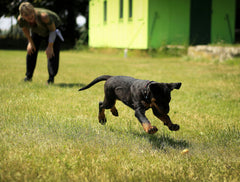
Anyone who has ever owned a dog can tell you that canines can sometimes exhibit some strange behaviors. You might notice your dogs doing funny things from time to time. Part of that is just being a dog - they run, jump, and have very little inhibitions about doing things.
However, sometimes those actions are causes for concern. If you've been wondering recently, "why do dogs chase their tails," because you've seen your pup doing that, you should know the top five reasons why this happens.
More often than not, it's harmless, but occasionally, it can be something that should prompt a vet visit!
Why Do Dogs Chase Their Tails? Usually, It's Boredom

As noted in the introduction, most of the time, if you notice your dog chasing tail, it's merely boredom. Dogs can sometimes entertain themselves by chasing their tail - they turn it into a game.
Generally, you can verify that this is the cause by giving your dog more stimulation. If your canine friend is doing it at the park, consider playing fetch with them, walking them, or petting them. If you see this behavior go down with attention, you can be almost sure that it was nothing but boredom.
Fleas and Other Skin Conditions

On the other hand, sometimes chasing can signal something more serious. If you notice your dog biting tail, there's a good chance that something is amiss. Since dogs cannot scratch themselves, they typically use their teeth for this purpose. Fleas and other parasites (e.g., ticks) are itchy! So you might notice your dog trying to bite their tail when this happens.
If you see this behavior, you should first try to inspect the tail yourself. If you don't see anything and the behavior persists, consider booking a trip to the vet. A trained vet can look at the tail and figure out why your pup continues to attack it. Once you're sure that your pet has fleas, you can then ask your vet for their recommended treatment options like using a flea collar such as our Natural Flea & Tick Collar.
Allergies

Sometimes an itchy tail (which causes biting and chasing) can be a result of allergies. In dogs, like most pets, allergies can frequently show up as skin issues. For example, if you recently switched your dog's food, you might be causing some form of allergic reaction. Or, perhaps they accidentally got their tail stuck in some poison ivy.
Usually, when this happens, you'll see some red skin or other markers to denote issues. You might see scales, welts, and other apparent signs of allergies. If you see these, you should book a vet appointment ASAP. The faster you isolate and identify what's causing the reaction, the better off your canine friend will be!
Why Do Dogs Chase Their Tails? They're Young!

If you have young puppies, you might notice this chasing behavior. In this case, the chasing tail meaning is not that serious or profound. A new puppy doesn't always understand that the tail is part of its body. As such, it's fascinating to chase! You might notice your puppy furiously trying to catch its tail, not knowing that it's attached!
If you notice this behavior, keep an eye on the chasing action. If you have a dog that can catch its tail, your pup may try to bite it. Of course, if they do that, they could be in for a world of pain! Therefore, you should monitor the situation and discipline/correct as necessary. You're better to step in and stop the behavior early rather than spend a significant amount of time at the vet later!
Stress

The last reason why dogs chase their tails is stress. Sometimes, when dogs feel anxious or nervous, they engage in repetitive behaviors. Those behaviors help to calm the dog. Think about what happens when humans get stressed. They frequently seek out something mundane, repetitive, and easy to help calm themselves down.
Breathing in deeply, doing some stretches, or going for a walk are examples of what humans might do. Dogs might chase their tails to distract themselves from the anxiety.
If you suspect that your dog chasing tail might be due to stress, consider what might be aggravating them. Is there a new home situation, another dog present, or something else that might be giving them anxiety? Can you provide your dog with some space to survey the landscape? Or, perhaps you can pet your dog to make them feel a little more at ease.
No matter what works for your dog, consider doing what you can to make them feel more relaxed. You might find the tail-chasing goes away!
Why Do Dogs Chase Their Tails? A Variety of Reasons

There are, unfortunately, many reasons why a dog might chase its tail. The five mentioned above are the most common ones. However, there are others (like a mental illness like obsessive-compulsive disorder). If you notice your dog tends to be chasing its tail too often, consider the reasons above and see which one might be affecting your pup.
If it's something you can correct, it probably makes sense to initiate that training and comfort. However, if it's a medical condition, a vet trip is perhaps the best way to solve this problem!




